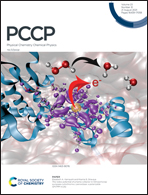New complexes of liquid crystal discotic triphenylenes: induction of the double gyroid phase†
Abstract
Electron donor–acceptor liquid crystals have been attracting considerable attention due to possible applications in optoelectronics and photonics. The creation of such charge transfer complexes is a powerful and flexible instrument for modifying the structures and properties compared to those of the initial components. In the present work, such an approach is exemplified on new complexes formed via non-covalent interactions of triphenylene discotics, namely, 2,3,6,7,10,11-hexakis(pentyloxy) triphenylene (H5T) and 2-(acryloyloxypropyloxy)-3,6,7,10,11-pentapentylox-triphenylene (TPh-3A), with an electron acceptor, β-(2,4,7-trinitro-9-fluorenylideneaminooxy) propionic acid (TNF-carb). The structure of thin supported films of H5T, TPh-3A and their blends with TNF-carb was investigated by grazing-incidence wide-angle X-ray scattering using a synchrotron source. At room temperature, the pristine discotics crystallize in orthorhombic unit cells whereas the self-assembly of H5T and TPh-3A with TNF-carb results in a double gyroid and hexagonal phases, respectively. Formation of the double gyroid phase with the lattice parameter of 36.5 Å is driven by phase separation between the aromatic and alkyl regions of the system. It is supposed that the TNF-carb molecules of the complex are positioned in the nodes of the structure while the H5T molecules are located in the struts adjoining the nodes via triple junctions. For the hexagonal crystal of the TPh-3A/TNF-carb complex, the acceptor molecules are likely located in the interstices between the neighboring supramolecular columns of TPh-3A. The molecular structures of the blends were also explored by means of FTIR spectroscopy. A detailed FTIR spectra analysis illustrates fine changes in inter-molecular bonds. For example, the initially dimerized acceptor molecules totally disappear in the complex structures whereas in TPh-3A/TNF-carb additional H-bonds between the carboxylate group in TNF-carb and the ester group of TPh-3A form. The experimental data allows putting forward possible molecular models of the complex structures.



 Please wait while we load your content...
Please wait while we load your content...